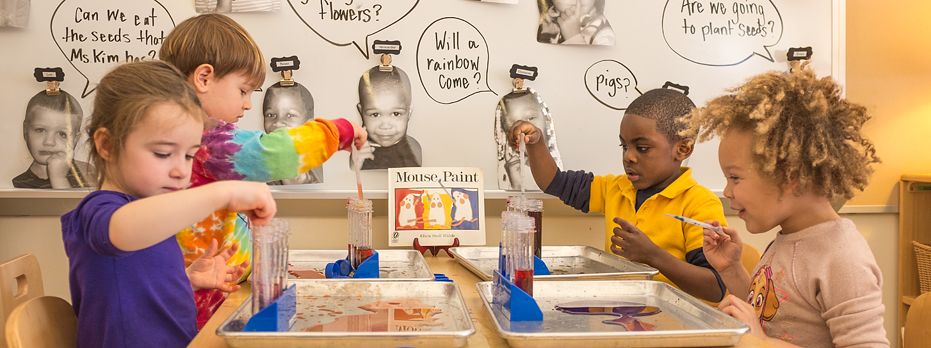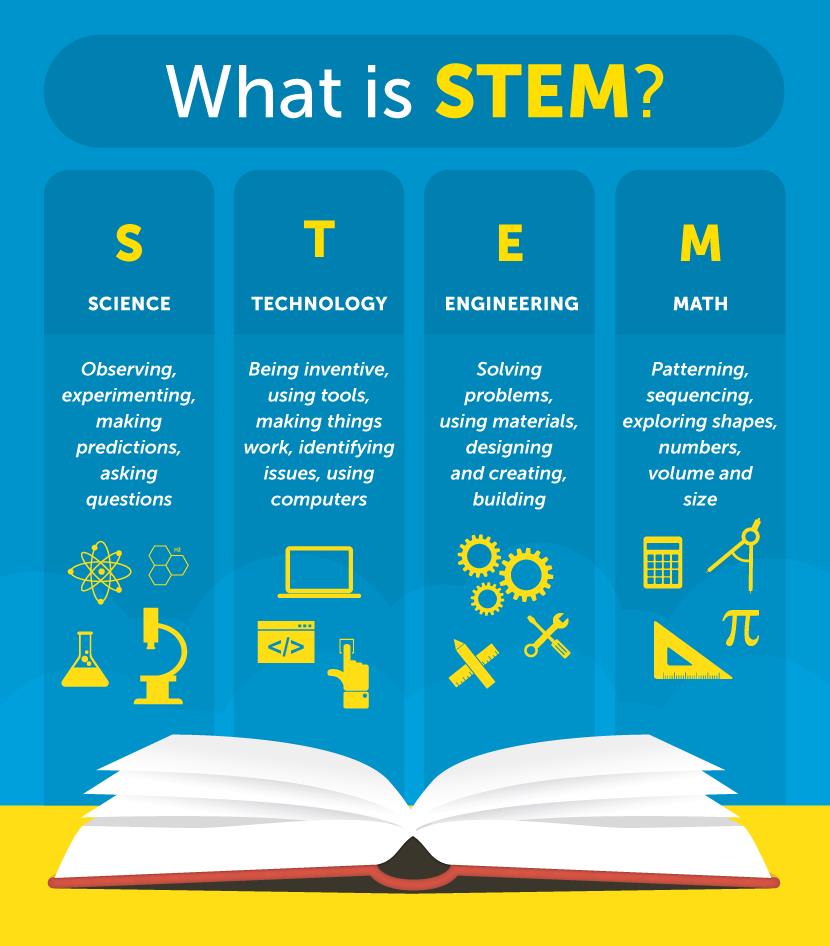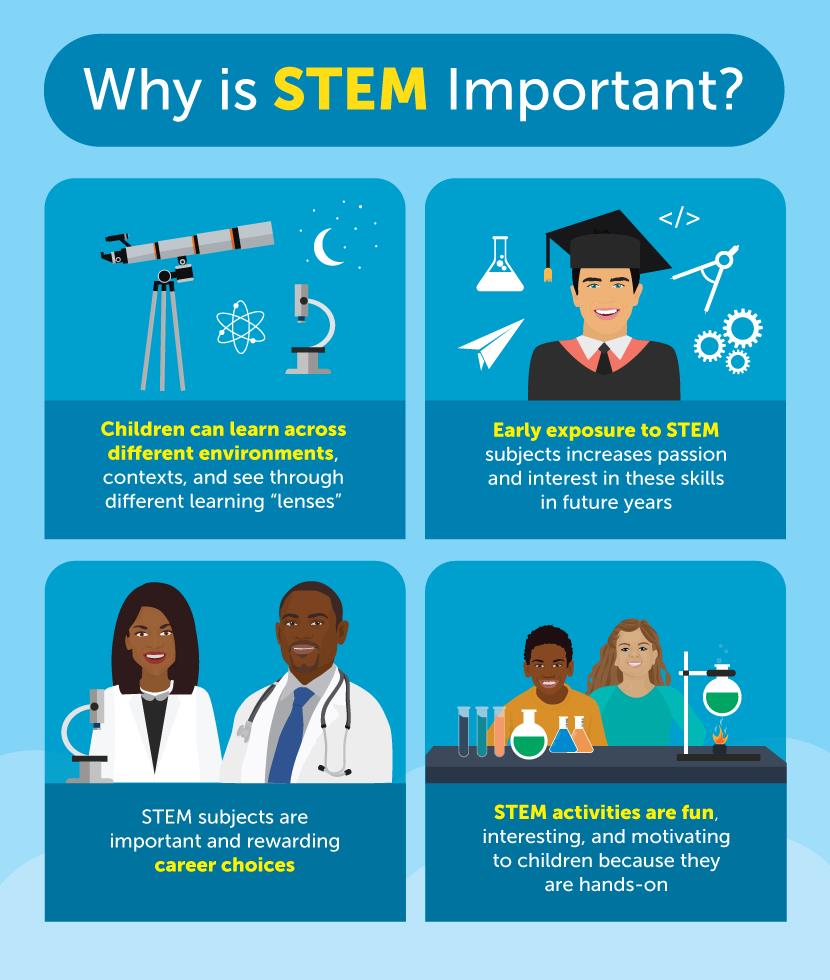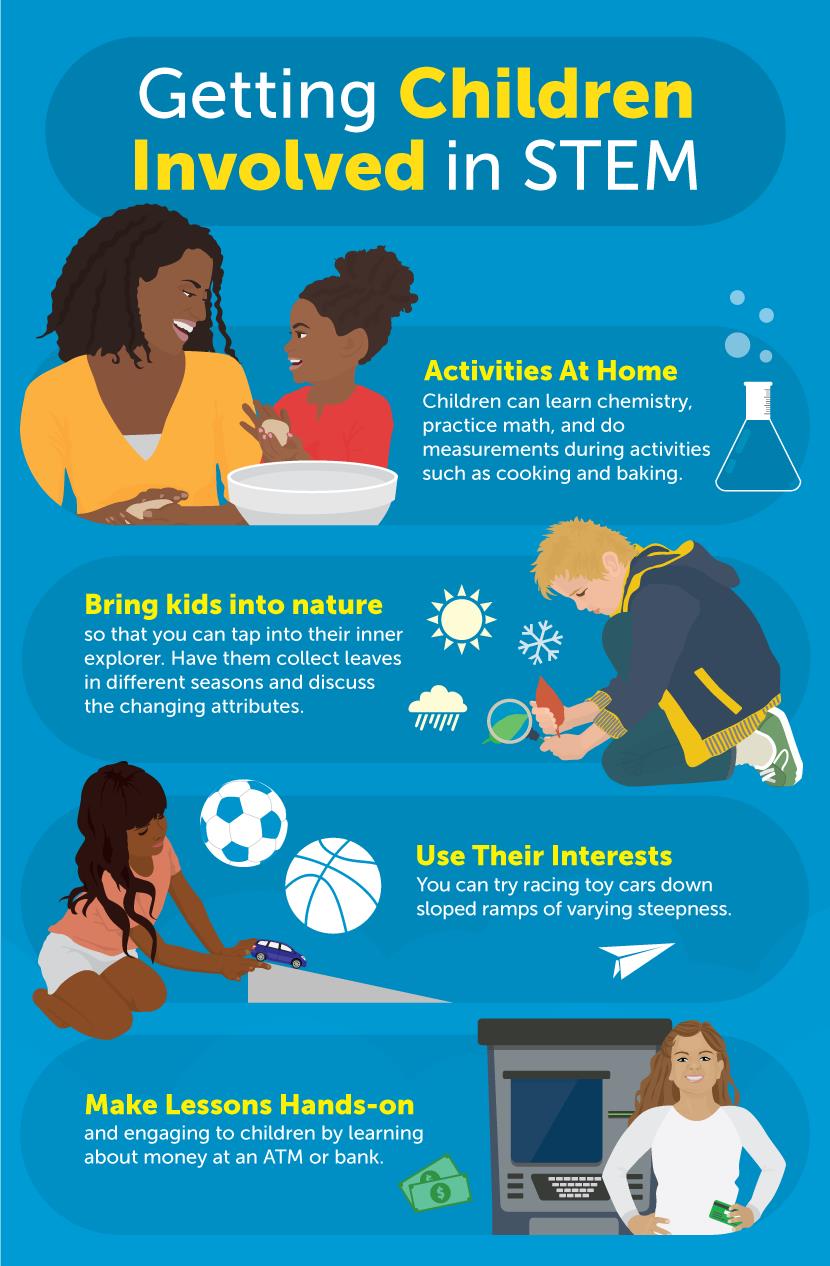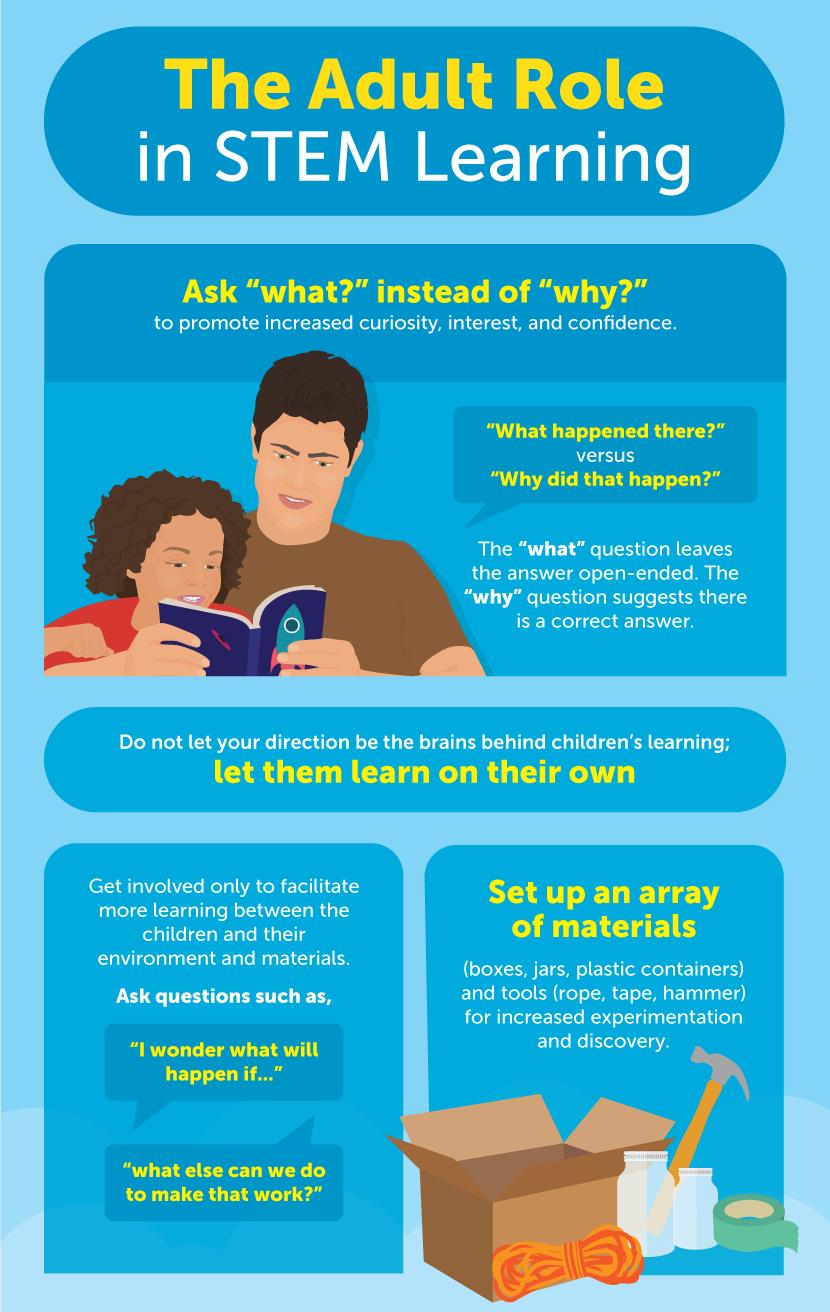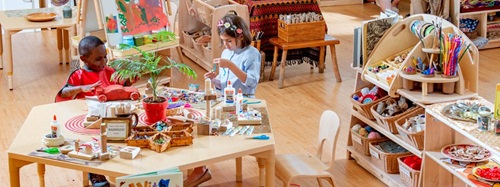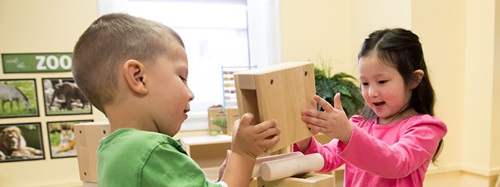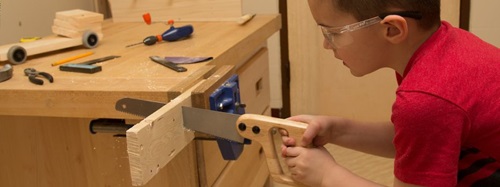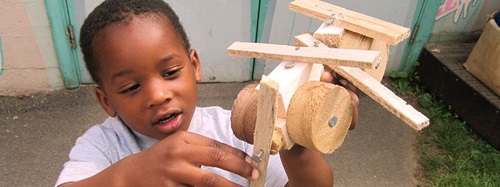Kids in STEM:
Science, Technology, Engineering, and Math
| January 2018Children are naturally curious about the world around them, always asking, “Why?” “What is that?” “How does that work?” “Why is that happening?” Their curiosity leads them to explore their environment, problem-solve, invent, and discover new things, which ultimately leads to future learning and development. It is through play that young children are able to engage in this learning process, and it is through play that adults can support and guide children’s natural desire to explore and learn about STEM ideas.
What Is STEM?
STEM stands for science, technology, engineering, and math. In one way or another, most of us engage in one of these activities every day. Today, in formal and informal learning environments, these concepts are being linked together to create an integrated curriculum.
SCIENCE is observing, experimenting, asking questions, wondering how things work, making predictions, sharing findings.
TECHNOLOGYis being inventive, using a variety of tools, making things work, identifying issues, using computers.
ENGINEERINGis problem solving, testing materials, designing, creating, building.
MATHis patterning, sequencing, exploring shapes, numbers, volume, and size.
Why is STEM Important for Young Kids?
Learning across contexts.To help a child learn to count, we can give them a paper worksheet or we could give them the opportunity to go outside, collect natural items, and practice counting with those materials. Children gain better understanding of concepts when we provide them with different contexts for learning and different lenses through which to explore.
Early exposure increases passion.When we expose young children to STEM ideas, we create a foundation for future passion and interest in these concepts, which may lead to continued learning and even a successful career in related fields.
STEM is important in 21st-century careers.In North America, careers in STEM fields are growing at a greater rate than any other occupation. These careers usually come with with higher-than-average incomes and play an important role in sustaining the economy. Science and technology have become very common in many occupations, and in many new careers, the most important skills are being able to quickly gain new knowledge and to innovate.
STEM is fun.Instead of memorizing facts or having an instructed class, children can play while they are learning. Many educators believe that play equals learning, and STEM skills can be easily developed through fun, engaging activities.
The Importance of Starting Young
Children at 1, 2, and 3 years old are active learners. Start with the foundations of STEM learning as soon as you can. Early experiences and learning shape the development of a child’s brain. The earlier that adults guide and support children’s wonder about their world, the more likely it is that children will experience positive development.
How to Get Kids Involved
STEM learning is more than education within school walls. Children may not realize that STEM concepts are embedded in every aspect of our lives, and as adults we can foster an appreciation for them. Here are some tips and activities that adults can do with young children to get them on track for school.
1. Make STEM part of everyday life.
Cooking:Search online for experiments that you can eat! Children can learn chemistry, practice math and measuring, and learn about food and plant anatomy.
Banking and shopping:When you’re in places that handle money (such as the bank or grocery store), you can teach children about principles of numbers, calculations, estimating, and other everyday transactions.
2. Bring kids into nature.
Nothing brings out a child’s sense of wonder and desire to explore like the outdoors, even if you’re just at the neighborhood park. You can engage in STEM activities by collecting rocks, leaves, bugs—anything!—and counting them, examining the materials, talking about shapes, and even coming up with hypotheses for what you think the different features do. Bring the items back home and use a magnifying glass to further examine and discuss what you’ve found.
3. Listen to their interests.
Use your child’s own interests as an opportunity for STEM lessons. If your child is into cars, you can do some playful physics lessons, such as comparing the speed of large and small toy cars and testing speeds on ramps. If your child likes basketball, have them throw crumpled-up paper into a wastebasket. Ask them to throw it from different heights and angles and try to make a basket by bouncing it off the wall. Discuss with them which was easier and more accurate.
4. Make it hands-on.
Children need hands-on activities and are much more engaged in the learning process when they can manipulate materials. You can create homemade slime, make a volcano with baking soda and vinegar, or build things. Visit an interactive museum, let your child assist you in assembling a shelf, or take an old phone apart and try to put it back together.
The Role of Adults in STEM Learning
Here are some ways that you can promote further learning and development in STEM:
Ask the right questions.A simple strategy for asking the right questions is to use “what” instead of “why.” “What” questions are more open-ended so children can answer with confidence even as their curiosity is piqued. Starting a question with “why” suggests that there is one correct answer. Try asking: “What do you see there?” “What are those birds doing” “What can you hear?” “What do you think will happen next?” “What did you notice there?”
Stay on the sidelines. Allow children to engage in their own exploration. Get involved only when needed to help them develop new skills and to facilitate play and learning with the environment. Ask open-ended questions to encourage deeper thinking about the activity they’re engaged in.
Set up the environment for success.Have a variety of materials and tools that children can access safely. Different types of materials can support children in furthering their experimentation and discovery.
STEM Activities to Try Today
SCIENCE:
- Identifying living versus non-living items.Collect materials outside or cut out pictures from magazines. Ask your child to sort the materials into living and non-living categories.
- Observing bubbles.Using objects like cookie cutters, bubble wands, and straws, have your child dip each object into soapy water. Ask questions like “Which shape do you think yours will be?” and see what difference it makes to blow fast or slow.
- Learning about seasonal changes.Collect leaves in each season. Have the children describe or draw differences and similarities among the leaves. Talk about how the leaves’ appearance changes during season cycles.
- Observing.Use a magnifying glass to look at something neat. What do the children see with the magnifying glass? What do they see without it?
TECHNOLOGY:
- Exploring different tools.Use a variety of tools (pitchers, cups, funnels, scoops) for pouring and scooping. Talk about what each item does.
ENGINEERING:
- Creating structures.Put a variety of building materials like foam bricks, Legos, boxes, plastic bottles, and cups in a box and create a list of challenges. How high can you stack different items? Build a tunnel you can push this car through. Build something as a team. Un-build your tower.
MATH:
- Sorting.Have children sort items such as sticks, leaves, nuts, seashells, and stones according to features such as size, texture, color, weight, and patterns.
- Patterning.Listen to popular songs and repeat patterns in the song with hand clapping, foot stomping, and body motions.
Learning STEM skills can be fun and motivating for children, and it’s easy to incorporate age-appropriate activities into routines at home and at school. Introducing STEM concepts at a young age increases the chance that children will continue to be interested in these subjects throughout their lives.
Article courtesy of FIX
More Resources:
http://successfulstemeducation.org/
http://engineeringforkids.com/article/02-02-2016_importanceofstem
http://www.bostonchildrensmuseum.org/sites/default/files/pdfs/STEMGuide.pdf
http://naturalstart.org/feature-stories/engaging-children-stem-education-early
http://littlebinsforlittlehands.com/what-is-stem-activities-kids/
http://thestemlaboratory.com/stem-activities-for-kids/
http://lifehacker.com/how-to-get-your-kids-interested-in-stem-without-forcin-1751361598
https://www.coderevkids.com/blog/what-is-stem-and-why-is-it-so-important-to-kids/
http://www.sciencepioneers.org/parents/why-stem-is-important-to-everyone
http://www.connectamillionminds.com/campaigns/stem-in-sports/

